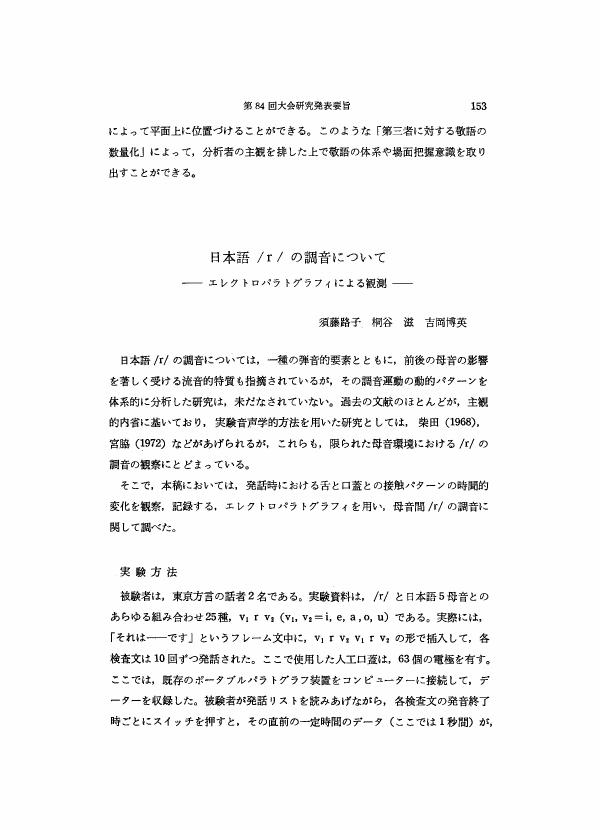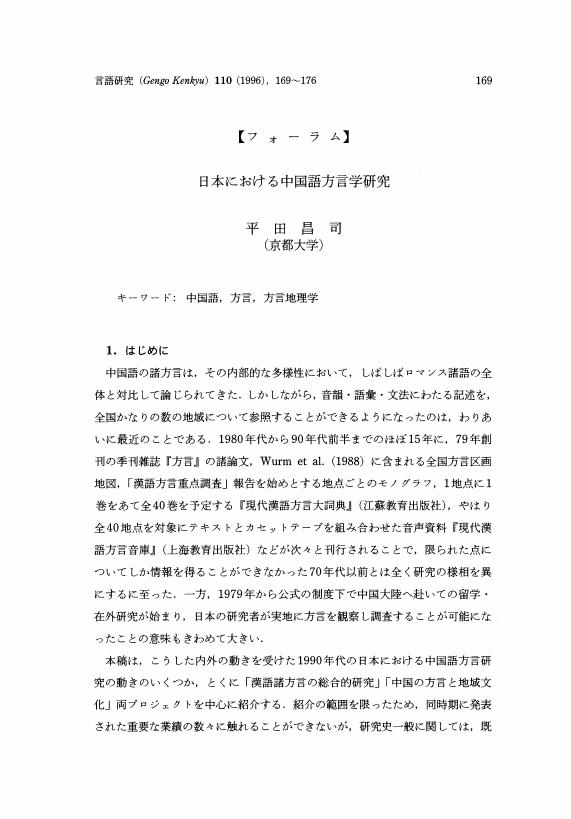1 0 0 0 アイヌ語の連體詞
- 著者
- 知里 眞志保
- 出版者
- 日本言語学会
- 雑誌
- 言語研究 (ISSN:00243914)
- 巻号頁・発行日
- vol.1941, no.7, pp.112-146, 1941
1 0 0 0 OA オーストロネシア語族と日本語
- 著者
- 崎山 理
- 出版者
- 日本言語学会
- 雑誌
- 言語研究 (ISSN:00243914)
- 巻号頁・発行日
- vol.2001, no.120, pp.97-105, 2001-12-25 (Released:2007-10-23)
- 参考文献数
- 14
1 0 0 0 OA 第46回大会研究発表報告要旨
1 0 0 0 OA 書評・紹介 築島裕 著 『国語学要説』
- 著者
- 亀井 孝
- 出版者
- 日本言語学会
- 雑誌
- 言語研究 (ISSN:00243914)
- 巻号頁・発行日
- vol.1962, no.42, pp.47-57, 1962-10-31 (Released:2013-05-23)
- 参考文献数
- 1
1 0 0 0 OA 書評・紹介 東条操 監修 『方言学講座4巻』
- 著者
- 池上 二良
- 出版者
- 日本言語学会
- 雑誌
- 言語研究 (ISSN:00243914)
- 巻号頁・発行日
- vol.1963, no.44, pp.53-58, 1963-10-16 (Released:2013-05-23)
1 0 0 0 アクセントの音程ときこえ
- 著者
- 杉藤 美代子
- 出版者
- 日本言語学会
- 雑誌
- 言語研究 (ISSN:00243914)
- 巻号頁・発行日
- vol.1971, no.58, pp.79-81, 1971
1 0 0 0 日本語アクセントの音程とその聴覚的弁別
- 著者
- 杉藤 美代子
- 出版者
- 日本言語学会
- 雑誌
- 言語研究 (ISSN:00243914)
- 巻号頁・発行日
- vol.1968, no.52, pp.111-113, 1968
1 0 0 0 動態測定による日本語アクセントの解明
- 著者
- 杉藤 美代子
- 出版者
- 日本言語学会
- 雑誌
- 言語研究 (ISSN:00243914)
- 巻号頁・発行日
- vol.1969, no.55, pp.14-39, 1969
1 0 0 0 代名詞と反最小性
- 著者
- 藤田 耕司
- 出版者
- 日本言語学会
- 雑誌
- 言語研究 (ISSN:00243914)
- 巻号頁・発行日
- vol.1991, no.100, pp.42-66, 1991
This paper argues against the traditional view that Japanese pronouns differ from English pronouns in that they can never be bound by an operator. Rather, it is shown that pronouns cross-linguistically have the property of ' Anti-Minimality, 'by which is meant that a pronoun can be operator-bound only if another operator intervenes between the pronoun and its binding operator. Thus, just as pronouns stand opposed to anaphors with respect to A-binding, so they also stand opposed to variables with respect to O-binding; both anaphors and variables have the property of Minimality for the relevant type of binding. Data from English, Chinese and Japanese are discussed, and it is argued that discrepancies in the distribution of operator-bound pronouns derive from the existence/nonexistence of the pertaining Anti-Minimality inducers in these languages, which in turn reduces to the parametric variations in their configurational structure. Thus English differs from Chinese and Japanese in that only the former has AGR, while Japanese differs from the other two in that it crucially lacks a subject. Hence the strictly limited occurrence of operator-bound pronouns in this language. Since this study shows that the concept of Minimality comes into play for binding as well as for government, it provides further motivation for the reduction of the ECP to the Binding theory.
1 0 0 0 南琉球宮古語池間方言・多良間方言の韻律構造
- 著者
- 五十嵐 陽介
- 出版者
- 日本言語学会
- 雑誌
- 言語研究 (ISSN:00243914)
- 巻号頁・発行日
- vol.150, pp.33-57, 2016
<p>琉球語南琉球語群宮古語の方言である池間方言と多良間方言は3種類のアクセント型が対立するいわゆる三型アクセント体系を有する。両方言のアクセント型の区別は広範な環境で中和する。また両方言は,日本語諸方言と比較して複雑なアクセント型の実現規則を有する。本稿は,両方言の韻律構造を記述するためには,2モーラ以上の語根および接語が写像される韻律範疇である韻律語を仮定しなければならないことを示す。また本稿は,韻律範疇を扱う理論的研究の知見を踏まえながら,問題の韻律範疇に韻律語の地位を与えることの妥当性に関する予備的な議論を行う。</p>
1 0 0 0 OA 日本語の系統:回顧と展望
- 著者
- 松本 克己
- 出版者
- 日本言語学会
- 雑誌
- 言語研究 (ISSN:00243914)
- 巻号頁・発行日
- vol.2001, no.120, pp.89-96, 2001-12-25 (Released:2007-10-23)
- 参考文献数
- 54
- 著者
- 清水 泰行
- 出版者
- 日本言語学会
- 雑誌
- 言語研究 (ISSN:00243914)
- 巻号頁・発行日
- vol.148, pp.123-141, 2015
この論文は,「熱っ!」のように,形容詞語幹が声門閉鎖を伴って発話され,感動の意味が表現上実現する文(形容詞語幹型感動文と呼ぶ)を扱い,「感動の対象」を表す「主語」をとるかとらないかに着目して考察する。その結果として,形容詞語幹型感動文について,①即応性と対他性による分析から,構造上の「主語」をとらないと考えられること,②「これうまっ!」における「これ」のような形式は,話し手が聞き手に注意喚起を呼び掛けるための「感動の対象」の提示部であること,③形容詞語幹型感動文を構成する形容詞の性質の違い(属性形容詞か感情形容詞か)の観点から,属性形容詞によるものと感情形容詞によるものの二種に大別できること,④属性形容詞によるものも感情形容詞によるものも体言化形式を持ち,名詞句として感動の表出に用いられることで同じ感動文として機能すること,という四点を述べる*。
1 0 0 0 OA 強調の種類
- 著者
- 川上 蓁
- 出版者
- 日本言語学会
- 雑誌
- 言語研究 (ISSN:00243914)
- 巻号頁・発行日
- vol.1957, no.31, pp.63-64, 1957-03-31 (Released:2010-12-22)
- 参考文献数
- 3
1 0 0 0 OA 日本語/r/の調音について
1 0 0 0 ナッテイルによる単純状態の叙述
- 著者
- 佐藤 琢三
- 出版者
- 日本言語学会
- 雑誌
- 言語研究 (ISSN:00243914)
- 巻号頁・発行日
- vol.1999, no.116, pp.1-21, 1999
Japanese has been described as a“<i>naru-language</i>”which emphasizes intransitive over transitive expressions. But many areas of the semantic range of <i>naru</i>(become)have not been fully investigated. This paper analyzes and provides a full description of one of these.<br>Although <i>natteiru</i>(having become)literally means a state which has come to exist as a result of change, there are some sentences in Japanese in which it actually describes a simple state. This paper classifies this phenomenon from the viewpoint of the recognition of a perceived state and concludes that the sentences in question explain cause/reason, function, or composition of the perceived state.<br>The basic meaninig of <i>naru</i> denotes the attainment of some sort of state in the real world. This paper regards the meaning of the sentenses concerned as a metaphorical extention from the real world to mentally constructed world predication.
1 0 0 0 日本語における弱強格フット:――舞阪方言からの証拠――
- 著者
- ポッペ クレメンス
- 出版者
- 日本言語学会
- 雑誌
- 言語研究 (ISSN:00243914)
- 巻号頁・発行日
- vol.150, pp.117-135, 2016
<p>本論文では,舞阪方言のアクセント体系を妥当に記述するために弱強格と強弱格という二種類のフットが必要であることを指摘する。フットを仮定せずに名詞のアクセント体系における体系的空白と,名詞・動詞ともに見られるアクセント交替を説明することはできない。興味深いことに,舞阪方言においては,東京方言と違い,強弱格より弱強格が優先される。強弱格も現れ得るが,語末モーラへのアクセント付与を回避するためだけであり,これ以外の場合は弱強格が選ばれる。これは,二種類のフットが同一言語のアクセント体系の中に共存し得ることを示す。</p>
1 0 0 0 現代日本語における助詞分類の基準
The standard to classify the particles or postpositions in the Modern Japanese is led to the scheme for the verbal conjugation.<BR>The conjugation has two divisions of mood and two divisions of aspect. Two of mood are indicatives (<I>yomu, yonda</I>, etc.) and optatives (<I>yomô, yondarô</I>, etc.); each division has five subclasses: indefinitive, definitive, copulative, predicative, and attributive (or infinitive). Two of aspect are imperfects (<I>yomu, yomô</I>, etc.) and perfects (<I>yonda, yondarô</I>, etc.); each division has three subclasses: introversive, extroversive, and retroversive.<BR>Now about the imperfect-indicatives, there are eleven forms: namely three indefinitives (extroversive “<I>yomi</I>, ” introversive “<I>yomuni</I>, ” and retroversive “<I>yomu to</I>, ”), three definitives (extroversive “<I>yomi</I>, ” introversive “<I>yomu nari</I>, ” and retroversive “<I>yomu to or yomusi</I>, ”), three copulatives (extroversive “<I>yomeba</I>, ” introversive “<I>yomu nara</I>, ” and retroversive “<I>yomu tara</I>, ”), one predicative (“<I>yomu</I>.”), and one attributive or infinitive (“<I>yomu</I>”).<BR>And then, in the scheme for the conjugation of the imperfect-indicatives, the basic particles (postpositions) may be put as follow: indefinite-introversive “<I>e</I> (illative), ” indefinite-extroversive “<I>yori</I> (comparative), ” indefinite-retroversive “<I>o</I> (accusative), ” definite-introversive “<I>made</I> (allative), ” definite-extroversive “<I>kara</I> (ablative), ” definite-retroversive “<I>dake</I> (restrictive), ” copulate-introversive “<I>mo</I> (additive), ” copulate-extroversive “<I>wa</I> (topical or themative), ” copulateretroversive “<I>ga</I> (subjective), ” predicative (-extroversive)“<I>sa</I> (designative), ” and attributive or infinitive “<I>no</I> (genitive)”.<BR>Additionally socalled postpositions “<I>ni</I> (dative), ”“<I>de</I> (instrumentative), ” and “<I>to</I> (commitative)” should be classify as the three indefinite forms of the copulative auxiliary verb “<I>da</I>.”
1 0 0 0 OA 日本における中国語方言学研究
- 著者
- 平田 昌司
- 出版者
- 日本言語学会
- 雑誌
- 言語研究 (ISSN:00243914)
- 巻号頁・発行日
- vol.1996, no.110, pp.169-176, 1996-12-20 (Released:2007-10-23)
- 参考文献数
- 9







